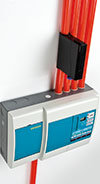

The introduction of outside (fresh or free) air is a widely adopted technique to manage indoor air quality and thermal load in buildings and premises of all types and sizes. Office buildings, data centres, industrial premises and even ships use outside air to maintain indoor air quality for human comfort and safety, prevent accumulation of particulate and gaseous contaminants and assist in reducing the operating cost of air conditioning systems.
The introduction of outside air, however, has the potential to introduce external atmospheric pollutants which might cause Aspirated Smoke Detection (ASD) systems to issue nuisance alarms due to their higher sensitivity compared to other fire detection systems. This presents a serious problem as ASD systems are regarded as a high integrity technology and should not alarm to an event that does not correspond to a real fire. As such, ASD manufacturers have employed different techniques to ensure their products do not issue nuisance alarms from external influences while ensuring adequate protection of the building.
Where outside air is used
Outside (fresh or free) air is introduced into a building intentionally, for a number of known reasons, and unintentionally. The intentional introduction of outside air is a widely adopted technique which serves many and diverse purposes such as maintaining indoor air quality for human comfort, assisting in the control of contaminants, temperature and humidity and for space pressurisation. The unintentional introduction of outside air occurs through the normal use of exterior doors and windows for entrance, egress and ventilation. This is known as infiltration.
Typical examples of intentional introduction of outside air include:
1. Buildings with high occupant density (offices, universities, hospitals, hotels, etc.) to maintain an acceptable indoor air quality (control of contaminants, odours and CO2) for human comfort. The introduction of outside air into these buildings is often mandated in building codes.
2. Ecologically Sustainable Development (ESD) or ‘Green’ buildings employing natural ventilation for heating and cooling purpose. Central to many ESD designs is an atrium or a large open space which allows outside air to flow into the interior of the building through external openings.
3. Commercial and institutional (correctional) facilities to remove environmental tobacco smoke (particulates and odour).
4. Emergency generator rooms to assist with cooling and prevention of overheating of equipment, provide sufficient air to combustion devices (boilers, water heaters) and ventilate the space to prevent build up of toxic CO levels.
5. Industrial and manufacturing facilities employing vertical or horizontal air displacement for human comfort and safety and for the removal of internally generated particulates and gaseous pollutants (odours, toxic gases, VOCs) in order to reduce physical damage to equipment and products.
6. Buildings where it is imperative that outside air makes up 100% of the supply air such as R&D facilities, laboratories and particular types of healthcare enclosures (infectious isolation rooms, autopsy rooms).
7. Electronic Data Processing (EDP) rooms:
• External air is introduced to ensure the conditioned space is pressurised in relation to the outdoors or from unconditioned spaces to prevent infiltration of contaminants.
• Reduce the operating cost of air-conditioning systems by introducing outside air when it meets certain criteria (temperature, humidity).
• Removal of internally generated gaseous pollutants such as H2 gas evolved from batteries in uninterrupted power supply rooms.
8. Sports and amusement centres where outside air serves to reduce the humidity of the environment (e.g. swimming pools).

Challenges to ASD systems
The introduction of outside air into the building assists in ensuring human comfort, space conditioning and reducing air-condition operating costs, but has the potential of introducing pollutants from external sources such as vehicle exhaust, industrial and mining operations, farming operations, forest fires, etc. These external pollutants can trigger smoke detection systems protecting the building leading to nuisance alarms and unwanted consequences including business interruption, process shut down, emergency response etc.
The problem with nuisance alarms due to external pollutants is exaggerated with ASD systems because they are more sensitive than conventional detection systems and utilise cumulative sampling that allow external pollutants to enter more than one sampling hole leading to an aggregate signal at the detector (i.e. increased background level). Though different techniques are used by ASD manufacturers to safeguard against nuisance alarming, all but one pose serious drawbacks that will compromise early fire detection, adequate protection of the building, or lead to a significant cost of the detection solution as outlined below:
1. Reduced detector sensitivity: With this approach the detector alarm thresholds are adjusted upwards to accommodate the rise in the building’s background level from external pollutants. This will, however, compromise early detection in applications where:
• Detection of smouldering or small flaming fires is critical in ensuring business continuity (EDP rooms, laboratories, etc.).
• Smoke is expected to be diluted in large open space areas from the dispersion of smoke plume and the effects of stratification (warehouses, atria, etc.).
• Smoke is expected to be diluted in high airflow environments intended for heat dissipation or particulate control (EDP rooms, industrial/manufacturing facilities, etc.).
2. Reduced detector area coverage: Certain installation standards (i.e. NFPA76, FIA CoP) recommend high sensitivity at the sampling holes to ensure very early fire detection in specialised applications (i.e. EDP rooms, clean rooms). Moreover, where there are many sampling holes it will be necessary to increase the sensitivity of the detector to counteract the effects of smoke dilution to achieve the recommended sensitivity at each hole. Thus with many holes the detector sensitivity will need to be further increased to levels that may approach the background level making the system prone to nuisance alarms should external pollutants enter the protected environment. Reducing the area coverage (number of sampling holes) of the ASD system will avoid such nuisance alarms because with reduced dilution, the detector sensitivity can be set to levels sufficiently above the background level. This approach, however, will significantly increase the cost (installation, on-going service and maintenance) of the fire detection solution as more detectors will be required to protect a given area.
3. Altering the location or density of sampling holes: The aim of this approach is to avoid or minimise the encounter between sampling holes with external pollutants. This might lead to inadequate protection as smoke particles from a fire event might be transported by outside induced air-currents ‘away’ from the location of sampling holes.
4. Relative Scaling – ‘adaptive’ alarm thresholds: Detectors employing Relative Scaling perform continuous statistical analysis of the background level to adjust their alarm thresholds in the event of external pollutants entering the protected environment. This approach, however, is based on certain flawed assumptions:
• Relative Scaling allows automatic adjustment of the alarm thresholds to suit variations in the background level due to external pollutants. This is a flawed approach since it cannot be assumed that the history of background level variations can be safely used to adjust the alarm thresholds required for identifying a real fire threat.
• Relative Scaling is predicated on the assumption that changes in the background level due to external pollutants occur at a significantly slower rate than the rate of rise of an incipient fire. Experience and measurements show that a change in atmospheric pollution levels can be as rapid as a simple shift in wind-direction (e.g. within minutes a sea-breeze can be replaced by one that is laden with smoke from distant forest fire or city pollution). Conversely, incipient fires have been known to smoulder for hours, or even days, before making the transition to a dangerous rapid-growth fire over which time the detector is systematically desensitised without the knowledge of the facility owner, delaying any early warning response.
In contrast to the above approaches, Referencing is an effective, proven and less costly technique guarding against nuisance alarms due to external influences, whilst allowing the detector to maintain sensitive alarm thresholds for the earliest possible warning of a fire in the protected area. Referencing is the approach that Xtralis VESDA detectors employ when such changes in the background level are expected.
The Referencing approach measures and subtracts the effects of external influences and involves using a detector sampling from outside the protected area to appropriately moderate the sensitivity of detectors inside. One VESDA detector is used to analyse the incoming outside air and produces a reference reading of the level of pollutants. The reference reading is then subtracted from all VESDA detectors monitoring the internal building area.
This allows the internal VESDA detectors to determine if a rise in background level is due to external pollution or a fire event inside the protected area. This ability to ascertain the origin of an increase in background level greatly reduces the chances of VESDA detectors issuing nuisance alarms whilst ensuring optimum sensitivity.
Referencing, in addition to compensating against external pollutants, is also applied against internally generated pollutants which might enter other 'clean' areas of the building/premises.
VESDA detectors can be confidently applied in this fashion as they are absolutely calibrated devices with clean air barriers, and other optical arrangements, that ensure that the true sensitivity of each detector does not drift over time – either due to contamination or in response to the implementation of 'drift compensation' or other flawed practices, all of which result in compromised smoke detection capability.
For more information, contact Derek Waddell, regional sales manager, Xtralis, +27 (0)82 316 2601, dwaddell@Xtralis.com

© Technews Publishing (Pty) Ltd. | All Rights Reserved.